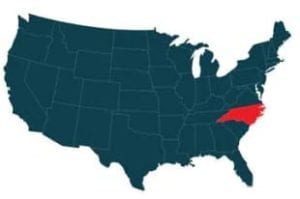North Carolina Emergency Vehicle Light State Statutes
All first responders in North Carolina, as well as many special use vehicles, are required by law to use warning and safety lights. The color, location, and size of each type of vehicle lights are determined by specific laws. Such lights are required to perform the role of police and other emergency personnel, and to keep the public safe and aware of possible road hazards.
It is good to be aware of the different types of light colors and systems of emergency vehicles so as to respond in a safe and timely way. Please leave plenty of room in traffic to navigate emergency and utility personnel. Wherever possible, more off the road so that law enforcement or other emergency vehicles can safely pass by and continue as quickly as possible to their destination.
Police Lights
City police in North Carolina have for almost a hundred years traditionally used forward-facing blue lights. However, some cities, like Winston-Salem, have changed in recent years to a combination of blue and red flashing police lights on top of their vehicles. Security grounds for the move are resolved. In daylight hours red lights have been shown to be more visible.
At least 83 per cent of police cars in North Carolina must be marked. Police car lights are mounted on regularly marked vehicles above the windshield. The remaining unmarked cars may be fitted with or without interchangeable outside lights. There are various ways to confirm the legitimacy of an unmarked police car, such as alternating headlights and strobe lights that can not easily be installed on a regular vehicle.
A blue light bar is still used by sheriff vehicles and state troopers. A 2017 law prohibits the general motorists from using light bar lighting systems. Blinking or strobing blue lights indicate that a law enforcement officer fulfills his or her duty, and other vehicles are required to stop or move out of such vehicles ‘ way.
Fire Fighting Vehicles
In North Carolina both municipal and rural firefighting vehicles are equipped with flashing red warning lights along with their sirens, whether paid or voluntary workers. Also, any vehicle in use by the State Fire Marshall or any of its representatives in carrying out their duty is equipped with flashing red lights as well. All operators of regular fire-fighting and fire-rescue vehicles must also receive a North Carolina Fire Apparatus Driver-Operator Certification after completion of extensive training courses Flashing red fire truck lights are required in the performance of their duties for any county fire marshall or assistant fire marshal. Warning lights are required even when the county doesn’t own the vehicle.
Emergency Medical Vehicles
Ambulances in North Carolina also use flashing red lights in the municipal and rural setting on both the front and back of their vehicles. These vehicle drivers are required to take part in a 6-hour classroom course and to pass a performance test with a licensed instructor before performing this specialized job.
Other medical service vehicles which can use flashing red light are doctors or anesthesiologists who respond to a hospital emergency call. Vehicles involved in transportation of human tissue or transplant organs may use a flashing red light for time-limiting reasons. A vehicle that has been approved as a volunteer life-saving organization by local authorities may also use red warning lights, whether the vehicle is owned by the organization or an individual, as long as they are responding to an official call.
Tow Trucks
All types of wrecker vehicles are expected to be fitted with flashing amber lights in North Carolina. Those lights should be visible up to 500 feet away. Lights should be turned on as soon as the service truck starts tow a car. If towing a vehicle with a width of 96 inches or greater, amber lights are used, or wider than the service vehicle.
Construction, Road Vehicle
Construction, road maintenance vehicles, or construction vehicles are equipped with amber warning lights. Those lights are also required during the actual performance of any road work, whether new construction or maintenance, for related road equipment including that operated by either the Department of Transportation or private contractors. Vehicles belonging to construction companies must always be clearly visible by being fitted for a range of 500 feet with flashing amber signals.
Utility Vehicles
Vehicles used to operate about roadside objects such as signs or wires also need to be clearly marked in the interest of safety. These and other other North Carolina utility vehicle laws are marked with amber blinking or strobing lights that are visible for a distance of at least 500 feet to work on utility pipes or other structures under the road.
Pilot Vehicle
All North Carolina pilot vehicle operators must be licensed by the North Carolina Department of Motor Vehicles. Vehicles over 2000 pounds need signs on a yellow background, with the words “OVERSIZE LOAD” or “WIDE LOAD.” Flashing amber lights have to be mounted over the engine. The lights can either be revolving beam or strobe light, with a base 5 inches in diameter and a height of at least 4 inches.
Security Vehicles
Some mall or other safety vehicles may not use any warning lights for safety reasons, while they may be clearly identified by painted markings. These vehicles must remain in a specific area, and their power to locate and arrest suspected lawbreakers is restricted. We do, however, have the right to investigate and order any remotely suspicious person to leave the premises. The typical color light used is white or yellow for safety vehicles that do have them.
For more details on what lights are available to you, please call your State Highway Patrol office at: 919-733-7952
* Please note that these numbers are what we can currently find, and the numbers may have changed since this page.


